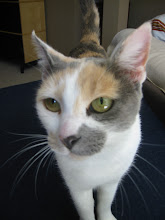While I'm not in Mexico, I had originally thought I'd use this blog to talk about the great desserts I try in the places I go. I haven't done much of that, but every once in a while it comes up.
So, I've been tentatively exploring "mexican chocolate" recipes for a bit, but not regularly. Tentatively because I don't have a high tolerance for capsaicin. (Capsaicin is what makes hot peppers hot). I tend toward the mild end of the spectrum usually. While I like the addition of subtle heat to chocolate, I also want to make something that satisfies those friends who love adding hot peppers and hot sauce to every meal.
I've tried this with truffles once, which went OK, but not well enough for me to want to repeat too quickly. I wasn't satisfied with my method (which was really a shot in the dark).
Recently I've been manipulating a brownie recipe. This has been fun. My first batch I think was a bit subtler than intended - after all, I'd rather err on the side of caution than not want to eat the brownies. The second round took it up just slightly, an improvement I think.
If you want to try your own mexican brownies, it's a piece of ... well, it's easy. Just take your favorite brownie recipe designed for a 9x13 pan. For moderately spicy brownies, add to the dry ingredients 1 teaspoon ground cinnamon, 1/4 teaspoon red cayenne pepper (ground powder), 1/4 teaspoon chili powder. (Adjust the spices up or down depending on what you want - I'd suggest the cayenne + chili powder be between 1/4 and 3/4 teaspoon total. You can use all cayenne or all chili powder; I like the combination.) I'm sure this would work with box mixes too - they often make less volume of brownies, so you might want to a little less spice added.






